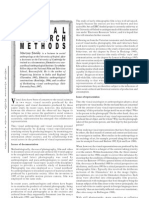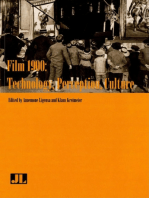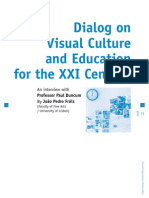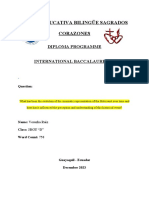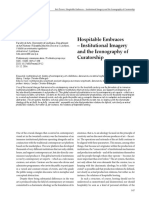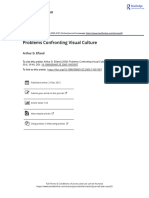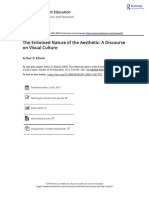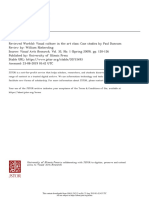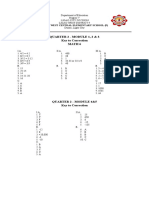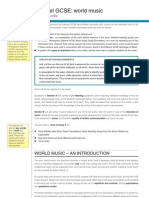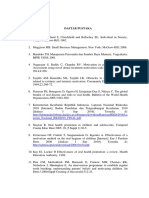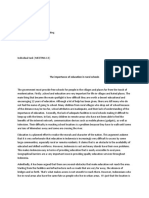Visual Culture of Control
Visual Culture of Control
Uploaded by
Elver ChaparroCopyright:
Available Formats
Visual Culture of Control
Visual Culture of Control
Uploaded by
Elver ChaparroCopyright
Available Formats
Share this document
Did you find this document useful?
Is this content inappropriate?
Copyright:
Available Formats
Visual Culture of Control
Visual Culture of Control
Uploaded by
Elver ChaparroCopyright:
Available Formats
Studies in Art Education
A Journal of Issues and Research
ISSN: 0039-3541 (Print) 2325-8039 (Online) Journal homepage: https://www.tandfonline.com/loi/usae20
Visual Culture of Control
Robert W. Sweeny
To cite this article: Robert W. Sweeny (2006) Visual Culture of Control, Studies in Art Education,
47:4, 294-307, DOI: 10.1080/00393541.2006.11650089
To link to this article: https://doi.org/10.1080/00393541.2006.11650089
Published online: 18 Dec 2015.
Submit your article to this journal
Article views: 78
View related articles
Citing articles: 4 View citing articles
Full Terms & Conditions of access and use can be found at
https://www.tandfonline.com/action/journalInformation?journalCode=usae20
Copyrighr 2006 hy the Studies in Art Education
National Art Education Association A Journal of Issues and Research
2006,47(4).294-307
Visual Culture of Control
Robert W. Sweeny
Indiana University ofPennsylvania
Correspondence Current discussions regarding the notion of visual culture in art educational
concerning this article practice center the actions of the viewer as participant within the nerworks of
may be sent to the visuality common in many contemporary societies. Surveillance technologies
author at the and techniques shift this notion of participation from active to passive, from
Department of Art and seeing to being seen. This article explores the relationship berween the gaze as
Art Education, 115
srructured by art educational practice and contemporary forms of surveillance,
SprowlsHall, 470 N.
looking to theoreticians who analyze power as it is formed within complex visual
11th Street, Indiana, PA
nerworks.
15705-1004. E-mail:
sweeny@iup.edu
Visual culture is becoming a common term within the field of art
Note: A previous education. While the term is increasingly familiar, the parameters of prac-
version of this article
was presentedat The
tices informed by and responding to visual culture are far from agreed
National Art Education upon. When researchers in the field discuss visual culture, they might be
Association Annual discussing television broadcasts (Freedman, 2003), professional wrestling
Conference in Boston,
(Duncum, 2002), clothing stores (Tavin, Lovelace, Stabler, & Maxam
Massachusetts, in 2005.
Specialrhanks to 2003), tourism (Ballengee-Morris, 2002), or any number of related socio-
Dr. Richard Ciganko cultural activities. Although each of these activities is quite diverse, one
for his feedback on an similarity is that individuals who participate in these activities can relate
earlierdraft.
to them; they are not relegated to the realm of 'high culture.' They are
common, understood through direct processes of engagement, based in
"practices of everyday life" (de Certeau, 1984).
Media theorist Nicholas Mirzoeff (I993, 2005) has written widely on
the topic of visual culture, defining it not as the products of consumer
and/or high culture, but rather as a cultural tendency towards employing
visual information as the privileged mode of representation and compre-
hension. In comparison to societies based in oral traditions or text-based
media, many contemporary cultures communicate through and under-
stand each other primarily through images. This distinction is important,
for two reasons: First, it affirms the importance for addressing visual
culture-based approaches in art educational practice, as this is a field that
is relevant to life in the 21st century. Second, it situates artistic production
as generative, specifically pointing towards the role of the art educator as
participant in the creation and understanding of contemporary forms of
visuality.
These forms of visuality are currently being formed, transmitted,
absorbed, and repurposed at a rapid pace. The terrorist attacks of
September 11th stand as one recent event that has dramatically shifted the
landscape of contemporary visual culture. The real-time broadcast of the
attacks on the World Trade Center twin towers have generated a variety
of visual responses, from online art exhibitions presented as a forum for
294 Studies in Art Education
Visual Culture of Control
shared grief and healing (Patton, 2004), to hoaxes that depict the
moment immediately before the second plane hit, to a recent project by a
British artist that reenacted the moments when individuals leapt to their
death from the burning skyscrapers ("9-11 art project," 2005). The thou-
sands of flyers desperately searching for information on lost loved ones
that appeared immediately after the attack, which later shifted into
impromptu monuments to the dead, also represent the extension of the
visual impact of September 11th (Mirzoeff, 2005).1 1As an aside, a frequent
comment rhar I heard
While these examples are by no means comprehensive, they seem to following September
indicate the variety of visual responses that the events of September 11th 11rh was rhat rhis cata-
have provoked. Responding to an event that is visually overwhelming strophic event was 'like
a movie.' References to
through visual means is, in many regards, to be expected, as still and Die Hard(I988), where
moving images were the primary means of documenting and transmitting German terrorists seize
the events of September 11tho However, these mediated events also mark a high-rise office
building in downtown
a dramatic shift in the notion of participation as related to 'everyday'
LA, only to be saved by
visual culture, in the U.S. and abroad. When images of individuals are a character played by
generated, catalogued, and used to reinforce stereotypes, as in the case of Bruce Willis, were
labeling young Muslim men as 'terrorists,' the discussion of visuality common, as were the
connections to similar
shifts from participation to punishment, from watching to being watched. blockbuster action
I will discuss this shift, and its importance to contemporary art education, films. How many refer-
through two intertwined topics: 'Reality TV' and theories regarding ences to catastrophes
broadcast primarily on
surveillance. audio technology, such
One increasingly large portion of contemporary visual culture (in those as the 1937 crash of the
societies linked to contemporary televisual networks) is the Reality TV Hindenberg, were
heard? How many said
show, where aspects of individuals' lives are filmed, edited, and replayed that the event was like
for large audiences.z These programs are undeniably popular. What is not the John Grisham novel
clear is the impact that these shows are having upon the general culture. in which terrorists use
planes in much the
Do they make individuals more aware of the cameras that are increasingly
same destructive
found in public spaces, or further conceal their presence? To what extent manner as AI Qaida?
do they glamorize the mechanisms of surveillance, making it attractive,
2Por a comprehensive
sexy, something to be extended and intensified? list of such programs,
Reality TV, for better or worse, is a part of the contemporary visual and their sociocultural
importance, see
culture for many societies. The shows may simply entertain, or they may
Andrejevic (2004).
blur the line between entertainment and everyday life, working to blur
the boundaries between the self and a mediated 'reality' (jagodzinski,
2003). In regards to the theme of this article, they may educate in ways
not conceived by traditional educators. As Andrejevic (2004) suggests,
Reality TV glamorizes the obsessive monitoring of daily life. This may
not be a problem for the participant/characters on the shows, as they have
provided consent. But what of the documentation of daily life that
happens outside of 'The Real World?' What of the surveillance cameras
that are increasingly found in urban, suburban, and even rural public
spaces? Does the visual culture of Reality TV anesthetize individuals to
the social effects of surveillance? Worse, might it make such surveillance
Studies in Art Education 295
Robert W. Sweeny
appealing? In order to explore these issues, it is important to first discuss
the history of surveillance technologies and theories. Tactics of identifica-
tion and critique carried out by contemporary artists and collectives will
then be discussed, in order to indicate potential responses for art educators
operating within, and perhaps perpetuating, a visual culture of control.
Panopticism, Past and Present
Surveillance is a part of social existence (Lyon, 1994). French for "a
view from above," surveillance is important for group interaction, child-
rearing, and communiry health in general. As such, it is challenging to
clearly determine when surveillance is helpful or a hindrance, improving
quality of life or infringing on civil liberties. There have been many
important studies regarding the social sciences and practices of surveil-
lance (Marx, 1990; Lyon, 1994; Parenti, 2003). One of the most influen-
tial is Discipline and Punish: The Birth of the Prison, written by Michel
Foucault (1977). This text is a study of the social shift from corporal
punishment to incarceration that uses the concept of the Panopticon to
describe these modern forms of social control.
The Panopticon was a prison, designed but never built by philosopher
Jeremy Bentham in 1787, which consisted of a centralized guard tower
surrounded by a circular ring of cells. The architecture made possible the
viewing of many prisoners by one guard. This control was aided by bright
lights that would shine from the exterior of the prison to the interior,
allowing the singular guard to identify motion easily, while cloaking his
identity from the prisoners.
Foucault theorized that modern societies that have moved from incar-
ceration to social regulation take the Panopticon as their model of
control. The individual in a panoptic society incorporates the mechanics
of control, modifYing their behavior as if they were being watched,
regardless of whether they actually are. Foucault proposes that this
embodiment of control is most effective when it is woven throughout the
fabric of social life, connecting schools, factories, prisons and the military
in a meshwork of control.
There have been many theoretical responses to Foucault's (1977)
discussion of panoptic control, addressing the possibilities for inverted
power relationships in the form of synoptic power (Mathiesen, 1997) and
sousveillance (Mann, Nolan, & Wellman, 2003), as well as the gendered
nature of disciplinary power (Bartky, 1990) and the lack of acknowledg-
ment of specific forms of embodied resistance (Hayles, 1999). More
recently, David Lyon (1994) theorizes that the extensive electronic
networks increasingly used to monitor and catalog behavior represent an
updated form of the Panopticon, which he terms the "Electronic Eye."
Lyon is quick to mention that these contemporary technologies are far
more extensive than Foucault could have imagined, however, and are also
far more visible than the 'diagram of power' envisioned in Discipline and
296 Studies in Art Education
Visual Culture of Control
Punish (Foucault, 1977). The visibility of contemporary surveillance tech-
nologies contradicts the subtle and pervasive embodiment of power repre-
sented by panoptic control. Contemporary surveillance exists in many
forms, the most prominent of which are based in the collection of both
visual information (convenience store closed-circuit cameras, camera-
equipped cell phones), and data (Radio Frequency Identification (RFID))
tags on foods, goods, and swipe tags on school ID's. The increasing possi-
bilities for dataveillance, including 'identity theft,' may represent a new
social power dynamic: what Gilles Deleuze (1992) describes as "The
Societies of Control."
A move away from centralized, panoptic social control, to power that is
decentralized may signal an extension of the potential to oppress, or
provide the openings that allow for resistance. New forms of surveillance
proliferate at an amazing rate, with social repercussions that have yet to be
documented. Issues related to individual safety and civil liberties have
become even more prevalent, and more polarizing, following the attacks
of September 11tho
Surveillance and the City
The events of September 11th 2001, changed many aspects oflife in
the United States. One of the most prominent changes relates to feelings
of safety and security, particularly in regard to public transportation. The
images of Mohammed Atta caught on surveillance cameras as he boarded
the plane used to destroy the twin towers was a visual reminder of what
many felt were lax security standards at airports.
As Lyon (2002) argues, the events of September 11 have set into motion
numerous forms of surveillance that he terms the 'phenetic fix.' This
includes the development of face recognition software, famously ineffec-
tive at establishing identity, as shown through its use at the 2001 Super
Bowl (McCullagh, 2001), and other biometric methods of cataloging
personal information, such as fingerprinting all visitors to the U.S. Soon
after September 11th, The Department of Homeland Security was estab-
lished, and the USA Patriot Act was signed into law by George W. Bush
on October 26, 2001, giving law enforcement authorities expanded access
to surveillance procedures and search and seizure techniques. Both
instances extend the 'phenetic fix' of surveillance techniques into the realm
of the U.S. legal system, and filtering through everyday life in the U.S.
Prior to September 11th, however, data were already being collected
and sorted in many public spaces in the United States via surveillance
technologies. According to the NYC Surveillance Camera Project, as of
1999, the borough of Manhattan in New York City had over 2,400
surveillance cameras in operation in public areas (http://www.mediaeater.
com/cameras/overview.html). The majority of these cameras are privately
owned, which does not raise concern when the cameras are trained on
restricted areas. Unfortunately, it cannot be accurately determined if
Studies in Art Education 297
Robert W. Sweeny
many of these cameras can view portions of public property. The New
York American Civil Liberties Union (ACLU) has recorded the locations
of these cameras and has recently released a report that serves as an alarm
concerning the state of the "surveillance-industrial complex" (Stanley,
2004).
The ACLU states that the relationship between business and law
enforcement following September 11th has resulted in a dangerous prolif-
eration of surveillance technologies and techniques. However, as suggested
earlier, there are also influential cultural forces that have normalized the
technologies of surveillance. New York has undergone major transforma-
tions, both in infrastructure and image, since it was called the "most
dangerous city in America" in the 1970s. Areas such as Times Square,
which was a haven for drug traffickers and prostitutes, have since been
transformed into major tourist sites. The watchful eye of the NYPD has
been replaced by the live TV camera shots of The Today Show and MTV's
TotalRequest Live. In this manner, social control might be seen as shifting
from police presence to televisual entertainment and resultant commerce.
An influx of tourists, cameras at the ready, might more effectively deter
crime than the predictable police patrol. This may represent a decentral-
ized form of surveillance that is closer to the networks of vision that bind
societies in healthy communities, a point to which I will return later in
this article.
New York is by no means the only U.S. city that employs surveillance
technologies. In 2003, the Chicago Police Department announced the
addition of 250 'smart' surveillance cameras that would connect with the
2000 cameras already in use, at a cost of $8.5 million paid in part by a
grant from the Department of Homeland Security:
Sophisticated new computer programs will immediately alert the
police whenever anyone viewed by any of the cameras placed at
buildings and other structures considered terrorist targets wanders
aimlessly in circles, lingers outside a public building, pulls a car onto
the shoulder of a highway, or leaves a package and walks away from
it. Images of those people will be highlighted in color at the city's
central monitoring station, allowing dispatchers to send police
officers to the scene immediately. (Kinzer, 2004)
The fact that these cameras require additional trained operators
familiar with the technologies did not deter them from being purchased.
As surveillance cameras become more advanced, so does their mainte-
nance and operation. The Chicago 'srnarrcams' begin to remove the
possibility for human error, replacing operator with algorithm. In the case
of developing technologies such as these, surveillance and dataveillance
merge in complex networks that shift traditional forms of seeing and
being seen, and that integrate more and more aspects of daily life. For
instance, you might be monitored walking down a city street as you with-
298 Studies in Art Education
Visual Culture of Conrrol
draw money from an ATM that records the transaction. If these two tech-
nologies were linked, they might indicate much more than your reason
for stopping; someone withdrawing a large amount of money who then
stops on the next corner might be buying drugs; someone who quickly
flees from the ATM might have robbed the machine. While these might
be plausible interpretations, there are many more that could apply.
Leaving the decision to a programmed machine might result in chaos,
which would only increase as the meshwork of networked surveillance
technologies grows more complex.
Though many cities in the United States are increasingly monitored,
the pinnacle of public surveillance can be found in Britain. As of 2001,
the UK has an estimated 2.5 million surveillance cameras in operation. A
nationwide public surveillance campaign was started in the early 1990s
when the IRA orchestrated a number of high profile bombings, including
the financial district in London. This campaign reached its frenzied peak
in 1993, when James Bulger was kidnapped by two l l-year-old boys at a
shopping mall. He was led from the mall, tortured, and killed. A grainy
shot from a CCTV camera helped investigators catch the culprits, rein-
forcing the social necessity for the widespread use of such technologies.
Those who argue for the implementation of surveillance in public areas
often claim that the cameras prevent crime. The individuals responsible
for the July 2005 bombings of London subway trains and buses were
identified by surveillance cameras; unfortunately, after the fact. The
perpetrators of the unsuccessful bombings that were to take place one
week later were identified and captured by British law enforcement using
surveillance footage, resulting in heightened security in New York
subways, including the proposal for wireless surveillance cameras in a
number of subway lines (Chan, 2005).
While surveillance cameras are helpful for identifying individuals in
the act of criminal behavior, they rarely are an effective form of crime
prevention. As an example, the general crime rate in the UK has risen by
4.3% in the 10 years since the James Bulger case ("Is crime out of
control," 2002). The ability of surveillance cameras to prevent crime
would primarily rely upon the clear demarcation of the cameras in public
spaces. However, all cameras in the UK are to be clearly marked, by law,
although some claim that up to 80% of CCTV cameras remain unmarked
(Honore, 2004). In the U.S., identification is not required of surveillance
cameras in public spaces, clearly calling into question their potential for
the deterrence of crime.
Issues of civil liberties, personal safety, and governmental protection
related to surveillance and dataveillance have become all the more relevant
in the years following September 11tho Are there connections between the
dynamics of vision and power reinforced by surveillance technologies and
the ways of seeing in operation in art classrooms? Are the spaces of art
Studies in Art Education 299
Robert W. Sweeny
education free from concerns of visual control, or might they extend and
reinforce similar diagrams of power? How can art educators respond to
these pressing social matters?
Panoptic Pedagogy
As Foucault suggests, schools playa major role in extending the perva-
siveness of social surveillance. Students are monitored through the collec-
tion of both visual and alphanumerical data. Although the visual forms of
surveillance are perhaps the most obvious, the collection of data is of
equal importance. In fact, in the history of surveillance in the United
States, data collection predated visual surveillance, as this information
could be consistently collected and easily shared (Parenti, 2003). In
public education this data collection takes many forms, most typically
through marking attendance, monitoring daily activities, and grading.
The physical structures of public schools in the United States have also
been designed to centralize control. In The American School 1642-2000,
Joel Spring (2001) discusses the importance of uniformity within public
school classrooms in the early portion of the 20th century. Beginning
with desks placed in grid formations that were bolted to the floor, many
educators sought to control student movement and behavior as much as
possible, influenced in part by the regimentation occurring in American
industry. In contrast to the beliefs of progressive educators such as John
Dewey, influential educational psychologists William James and Edward
Thorndike advocated for regimentation and teacher-led order in school
activities. These regimented activities were widely promoted by educator
William Bagley in his 1925 book Classroom Management, a text that was
reprinted 30 times between 1907 and 1927, influencing a generations of
educators (Spring, 2001).
The theories of behavioral psychologist B.F. Skinner were next to
inform approaches to classroom management in education in the middle
of the 20th century. Skinner proposed that schools could be scientifically
engineered to function optimally through both positive and negative rein-
forcements from management: i.e. teachers. He also suggested that educa-
tors borrow from developments in early cybernetic research:
The simple fact is that, as a mere reinforcing mechanism, the
teacher is out of date. This would be true even if a single devoted all
her [sic] time to a single child, but her inadequacy is multiplied
manifold when she [sic] must serve as a reinforcing device to many
children all at once. If the teacher is to take advantage of recent
advances in the study oflearning, she [sic] must have the help of
mechanical devices. (Skinner, 1968, p. 22)
Skinner called these mechanical devices 'teaching machines,' which
functioned by collecting small amounts of data from each student and
administering appropriate reinforcement. Although Skinner still empha-
sized a rigid classroom structure, the shift from centralized visual data
300 Studiesin Art Education
Visual Culture of Control
collection to digitized information processing marks a notable point in
surveillance within educational spaces. The program replaces the teacher
as data replaces vision.
The progressive education movement responded to Skinnerian educa-
tional theory by advocating for 'open classrooms' in the 1970s. Open
classrooms were designed to be free from rigid forms of organization,
both architectural and ideological. Although they were successful in
various manifestations, they were generally found to be unmanageable,
particularly within the institutional framework of U.S. public schools.
While classrooms have generally maintained centralized forms of organi-
zation, digital technologies have become increasingly decentered. As I will
suggest, the decentralized structure of contemporary networks such as the
Interent may present educators with the opportunity to diffuse the
centralized control of the classroom, providing opportunities for individu-
alization of information and reflection on the surveilled gaze.
The mechanistic theories of Skinner fit well with the social institutions
prominent in the U.S. during the 20th century: factories, corporations,
prisons, and hospitals. These are the comprehensive networks of control
described by Foucault (1977), who touches upon the relationship
between education and panoptic forms of control: "A relation of surveil-
lance, defined and regulated, is inscribed at the heart of the practice of
teaching, not as an additional or adjacent part, but as a mechanism that is
inherent to it and which increases its efficiency" (p. 176).
Foucault uses the examples of schools, hospitals, and military training
facilities, as well as prisons, to describe the extensiveness of panoptic
forms of control within industrialized societies. This begs the following
question: Is the Panopticon a relevant model for power in 21st-century
schooling environments, as many societies have shifted from industrial to
post-industrial organizational forms? As Garoian and Gaudelius (2004)
suggest, the spectacle of contemporary visual culture has supplanted
panoptic forms of control. While this may be the case, centralized forms
of surveillance and datavellance are nevertheless still reinforced through
institutionalized educational models worldwide.
It is important for educators to consider the shifts that are accompa-
nying socioeconomic changes, particularly in regard to expanding
networks of global trade and communication (Sweeny, 2004). One such
change resulting in new forms of regimentation and data collection can be
seen in newer educational trends in the U.S. such as the No Child Left
Behind (NCLB) Act. According to NCLB, schools can lose funding
according to their performance on standardized tests providing results to
the (centralized) U.S. Department of Education. While it claims to have
the potential to eliminate the 'achievement gap' between racial groups,
NCLB evaluation has been contested at many levels, as the collection of
data has been fraught with error, resulting in various forms of resistance
(Winerip,2005).
Studies in Art Education 301
Robert W. Sweeny
As previously stated, contemporary forms of surveillance are both
subtle and visible, based in alphanumerical data and visual information.
Many aspects of teaching depend upon the centralized control of the
teacher, a feature that is not inherently worrisome. What is worrisome is
when developing educational approaches emphasize increased freedom
and engagement, whether through governmental systematization or tech-
nological implementation, yet reinforce or multiply the repressive poten-
tial of centralized power.
Many schools are turning to technology in order to swing wide the
double-edged sword of safety and control. One prominent example is the
case of the Biloxi, Mississippi school district, who recently installed
surveillance cameras in evety classroom, at a price of $2 million, using
funds paid for by legalized gambling ("School district installs cameras,"
2003). Another recent example reflecting the use of dataveillance is the
Sutter, California school district who chose to end their trial run that
required students to wear ID cards enabled with RFID technology. This
technology, commonly used to track purchases in grocery stores, allowed
administrators to track student movement throughout the school. The
use of the tags was discontinued after challenges from parents, backed by
the Northern California ACLU (Zener, 2004).
What are the options for art educators concerned with the social
impact of these technologies? While invasive surveillance cameras can be
seen as a visible challenge to privacy and civil liberty, the cause for
concern might be just as great in schools where there are only eyes to see,
pencil and paper to record data. As Foucault (1977) and Lyon (1994)
suggest, the power to watch over extends beyond specific technologies
into general social behavior. By looking at the relationship between the
gaze of surveillance and how works of art are produced and viewed, art
educators might be able to develop strategies that allow them to critique
the panoptic in personal educational practice.
Reflecting/Redirecting the Panoptic Gaze
Artists have always relied upon complex networks of vision. The
notion of the 'gaze' has been interpreted and reinterpreted by a number of
theorists (Berger, 1972; Lancan, 1977; Mulvey, 1976; Zizek, 1991) to
describe the ideological components of these networks, mapping the
power relationships that works of art utilize, reinforce, and perhaps
critique. While these theorists are most interested in a variety of issues,
the 'gaze' can also inform practices of seeing related to the creation of
works of art in general.
Berger (1972) suggests that works of art tend to reinforce the cultural
norms related to the society in which they are produced. In Ways of
Seeing (1972), Berger clearly describes the influence of European oil
painting upon advertising, charting the ways in which cultural power is
translated through developing technologies in a consumer-oriented visual
302 Studies in Art Education
Visual Culture of Control
culture. The 'male gaze' perpetuated by oil painting and advertising rein-
forces the urge to consume, presenting women as object to be viewed and
possibly owned, and men as surveyor/owner. While he does not provide
suggestions for practices that address these inequities, Berger does refer to
the influence of the work of Walter Benjamin upon his theories, implying
the possibility for social change brought about through the mechanical
reproduction of images.
Benjamin (1968) famously suggested, in The Work ofArt in the Age of
Mechanical Reproduction, that developing technologies bring about new
ways of seeing that might influence social change. Film best represented
the potential for political and social transformation for Benjamin, as they
depict images previously unseen, in ways that shock individuals out of
complacency. They are also created and viewed in groups, representing
an opening of the social field with the ability for increased critical
participation.
The social transformations described by Benjamin were never realized;
in fact, the fascism of the Third Reich that he so resisted used these tech-
nologies to monstrous ends. Western cinema thus evolved into a reified
artforrn, reinforcing the beliefs and ideologies of the dominant culture.
Mulvey (1976) describes these traditions in psychoanalytic terms,
suggesting possibilities for a distinct break from the past. In her influen-
tial essay "Visual Pleasure and Narrative Cinema," she describes the
potential for a radical cinema that breaks from the sexist tendencies of
traditional film. She presents a psychoanalytic reading of film viewing,
suggesting that the destruction of the pleasure associated with film
viewing would represent a radical political act.
Central to Mulvey's reading of the filmic gaze are the three 'looks'
associated with film: that of the camera, the viewer, and the characters in
the film. She suggests that traditional film has emphasized the latter at the
expense of the former two. The camera produces an illusion that rein-
forces scopophilia, or pleasure in viewing that is removed from the
constraints of time and space (Mulvey, 1976). The viewer is therefore
distanced from the real aspects of the film, creating a fetishistic attach-
ment to the subjects: making them objects. The gaze of the characters is
therefore emphasized, reinforcing the power of the (typically male) main
character and the subjugation of the (female) sex object.
If the three 'looks' of the psychoanalytic film were to be mapped onto
the operations of the gaze of the work of art, might art students be
presented with similar critical options? In order to explore this notion, I
will now describe an activity carried out by students in ARHI 101:
Introduction to Art, an undergraduate art history course for non-majors
offered at Indiana University of Pennsylvania (IUP) in the Spring of
2005.
Studies in Art Education 303
Robert W. Sweeny
Looking at Looking
In their exploration of the male gaze and photography, students in
ARHI 101 were asked to bring in a personal photograph. They first
analyzed the photo according to the aspects of the male gaze discussed in
class: the power associated with the gaze of the subject in the photo, the
3In our activity we intent of the artist, and the interpretation of the viewer.J After they had
discuss the intent of the analyzed these aspects of their personal photo, they were asked to think of
artist in place of the
a location on campus that related to the photo in some way, either
gaze of the cameta as
described by Mulvey. through subject matter, theme, material, etc. They were then to place the
I believe that this is photograph on display in this location, sit close to the image, and watch
more relevant to our
the response of passersby.
discussion of intent
and communication in Following this activity, we discussed if any aspects of the gaze had
class, and bypasses the changed. Many came to the conclusion that the context in which an
problematic aspects of
technological deter-
image is seen does playa large role in how it is understood and inter-
minism implied by preted; while it might not change the meaning for the creator, it might
Mulvey-the camera add to its meaning. We also were able to discuss how anticipated
has no intent, it only
does as it is told.
responses might fall flat; images meant to shock might be easily over-
looked. In a social environment that is saturated with images, it is often
hard for one clear statement to be heard above the noise.
In this case, many students realized that, for a public work of art to
register with an audience, it is very important to take into account the
space in which it is displayed. They also gained quite a bit from being in
the same physical space as the image, not only watching responses, but
also allowing for their responses to be watched in turn. In taking part in
this activity, students were forced to engage with networks of vision
outside of the framework of the classroom; complex networks that allow
for multiple forms of feedback. It is this feedback that is lost when one is
monitored by surveillance cameras, when one has no idea who is
watching, and furthermore is restricted from watching the watcher. The
feedback that allows for healthy social interactions is short-circuited,
replaced by unidirectional, centralized control.
This activity was further complicated through the space within which
it took place. The Oak Grove on the IUP campus is the sight for the
'Grove Cam' a surveillance camera accessible through the IUP website
(available at www.iup.edu/grovecam). As the students became part of the
display of their photo and were able to be viewed on the Grove Cam
without their knowledge, it added another layer to our discussion of the
gaze. How does the existence of the 'Grove Cam' change how they inter-
pret their actions in the space? Since you can't make out the squirrels that
roam around the space, as encouraged by the site, what can you make
out? Individual faces? The gender of those in the camera eye? Her or his
skin color? Why is the webcam trained on this particular part of the Oak
Grove, which happens to be housed in the Administration building? Why
304 Studies in Art Education
Visual Culture of Control
is one of the most visible areas in the field of vision a piece of metal from
the World Trade Center, erected as a monument to September 11th?
In an era of Reality TV, cell phone cameras, and global digital networks,
it might be more relevant to ask not if we are being watched by another,
but from what position? Does making art in a state of constant surveillance
change how art is created? Presented? Understood? How have artists
responded to these situations, and are there possibilities for art educa-
tional models that draw from these responses?
These questions are particularly important, as the images that make up
our contemporary visual cultures are our own-images captured without
individual consent, catalogued outside of personal control, and repro-
duced in ways previously unthought. The ability to add to the flows of
information that make up contemporary visual culture might represent a
shift in the scopophilic nature of the gaze, from pleasure in watching to
pleasure in being watched. The use of decentralized networked technolo-
gies such as the Internet can allow for this type of participation to take
place, though educators should not overlook the potential for critical
engagement in the everyday spaces of the classroom, the campus, or the
city street.
Dense webs of technology, visuality, and power weave their way
through each of these spaces. Art educators have the chance to respond to
these situations, either to perpetuate centralized power structures through
obsessive data collection and reliance upon restrictive pedagogical archi-
tectures and other panoptic forms of pedagogy, or to actively engage with
and critique the visual culture of control.
References
9-11 art project sparks NY anget. (2005, June 17). BBe News. Retrieved December, 2005, from
http://news.bbc.co. uk/2/hi/entettainment/41 045 58.stm
Andrejevic, M. (2004). Reality Tv.. The work ofbeingwatched. United Kingdom: Rowman and
Littlefield.
Ballengee-Morris, C. (2002). Cultures for sale: Perspectives on colonialism and self-determination
and the relationship to authenticity and tourism. Studies in Art Education, 44(2), 232-245.
Bartky, S. (1990). Femininity and domination: Studiesin thephenomenology ofoppression. New
York: Routledge.
Benjamin, W. (1968). The work of art in the age of mechanical reproduction. In H. Arendt (Ed.),
Illuminations (H. Arendt, Trans.). New York: Schocken. (Original work published 1955)
Berger, J. (1972). Waysofseeing. New York: Penguin Books Ltd.
Chan, S. (2005, August 24). New cameras ro warch over subway system. The New York Times.
Retrieved August, 2005, from http://www.nytimes.com/2005/08/24/nyregion/24mta.html
de Certeau, M. (1984). Thepracticeofeveryday lift. Berkeley, CA: University of California Press.
Deleuze, G. (1992). Postscripts on the socieries of control. October59, Winter, 3-7. Cambridge,
MA: MIT Press.
Studies in Art Education 305
Robert W. Sweeny
Duncum, P. (2002). Wrestling with rv 'wrasslin', In j. jagodzinski (Ed.), [ournal jor Social Theory
in Art Education, 22.
Foucault, M. (1977). Disciplineand punish: The birth oftheprison (A. Sheridan, Trans.). New
York: Random House. (Original work published 1975)
Freedman, K. (2003). Teachingvisualculture. New York: Teachers College Press.
Garoian, C, & Gaudelius, Y. (2004). The spectacle of visual culture. Studies in Art Education,
45(4),298-312.
Hayles, N. (1999). How we became posthuman: Virtual bodies in cybernetics, literature, and
informatics. Chicago, IL: University of Chicago Press.
Honore, C (2004). Britain's big brother. Retrieved June, 2005, from
http://www.freespeech.com/archives/ 002424.html
Is crime out of control? (2002, July 17). BBC News. Retrieved March, 2006, from
http://news.bbc.co.uk/l/hilralkinl;...-pointI2118658.stm
jagodzinski, j. (2003). The perversity of (real)ity TV: A symprom of our rimes. Journalfor the
Psychoanalysis ofCultureand Society, 8(2), 320-329.
Kinzer, S. (2004). Chicago moving to 'smart' surveillance cameras. The New York Times.
Retrieved June, 2005, from http://quety.nytimes.com/gst/abstract.html?res=
F50914FE395DOC728EDDA00894DC404482&incamp=archive:search
Lacan, J. (1977). Thefour fundamental concepts ofpsychoanalysis. London: Hogarth Press, Institute
of Psychoanalysis.
Lyon, D. (2002). Surveillance studies; Understanding visibility, mobility, and the phenetic fix.
Surveillance and Society, 1(1), 1-7. Retrieved December, 2005, from
http://www.surveillance-and-society.org/articles II editorial. pdf
Lyon, D. (1994). The electronic eye: The riseofsurveillance society. Minneapolis, MN: University of
Minnesota Press.
Mann, S., Nolan, J., & Wellman, B. (2003). Sousveillance: Inventing and using wearable
computing devices for data collection in surveillance environments. Surveillance and Society,
1(3),331-355. Retrieved December, 2005 from http://www.surveillance-and-society.org/
articles I (3)/sousveillance.pdf
Marx, G. (1990). Undercover: Policesurveillance in America. California: University of California
Press.
Mathiesen, T. (1997). The viewer sociery: Foucault's 'Panopricon' revisired. Theoretical
Criminology, 1, 215-234.
McCullagh, D. (200 I, February 2). Call ir super bowl face scan I. Wired Online. Retrieved
December, 2005, fromhttp://www.wired.com/news/politics/O. 1283,41571 ,00.hrml
Mirzoeff, N. (2005). Watching Babylon: The war in Iraq and globalvisualculture. New York:
Routledge.
Mirzoeff, N. (1993). What is visual culrure? In N. Mirzoeff (Ed.), The visualculture reader. New
York: Routledge.
Mulvey, L. (1976). Visual pleasure and narrative cinema. In Amelia Jones (Ed.), Thefeminism
and visualculture reader. New York: Routledge.
NYC Surveillance Camera Project. (n.d.). Surveillance Camera Project Overview. Retrieved June,
2005, from http://www.mediaearer.com/cameras/overview.html
Parenti, C (2003). Soft cage: Surveillance in America,from slavery to the war on terror. New York:
Basic Books.
306 Studies in Art Education
Visual Culture of Control
Patton, R. (2004). "Why" project: Art in the aftermath. VisualArts Research. 31(1), 76-88. School
of Art and Design: University of Illinois at Urbana-Champaign.
School district installs cameras in evety class, hall. (2003, Augusr 13). CNN. Rerrieved March,
2006, from http://www.cnn.com/2003/EDUCATION/08/12/classroom.cameras.ap/
Skinner, B.F. (1968). The technology ofteaching. New York: Appleron-Cenrury-Crofis.
Spring, J. (2001). TheAmericanschool 1642-2000 (5rh ed.). New York: McGraw-Hill
Humanities.
Sranley, J. (2004). The surveillance-industrial complex: How rhe American governmenr is
conscripting businesses and individuals in the construction of a surveillance society. Retrieved
June, 2005, from http://www.aclu.org/SafeandFree/SafeandFree.cfm?ID= 16226&c=282
Sweeny, R. (2004). Lines of sighr in the "network society": Simulation, art educarion, and digital
visual culture. Studiesin Art Education, 46(1),74-87.
Tavin, K., Lovelace, L., Stabler, A., & Maxam, J. (2003). From Bucktown to Niketown: Doing
visual cuirural studies (Chicago style). In j. jagodzinski (Ed.), Journalfor SocialTheory in Art
Education, 23, 60-88.
The USA PatriotAct. Retrieved June 2005, from http://www.epic.org/privacylrerrorism/usapatrior/
Winerip, M. (2005). Holdours against srandard tests are under attack in New York. The New
York Times. Retrieved June, 2005, from
http://www.nytimes.com/2005106/15/education/15education.html
Zener, K. (2004). School RFID plan gers an F. Wired Online. Retrieved June, 2005, from
http://www.wired.com/news/privacy/O. 1848,66554,00.hrml
Zizek, S. (1991). Lookingawry. Cambridge, MA: MIT Press.
Studies in Art Education 307
You might also like
- (Law Express Q&A) Family LawDocument244 pages(Law Express Q&A) Family Lawvictoria ilavenilNo ratings yet
- Mapping Visual DiscoursesDocument55 pagesMapping Visual DiscoursesVanessa MillarNo ratings yet
- Visual Research Method: Marcus BanksDocument3 pagesVisual Research Method: Marcus Banksnu_01001110100% (1)
- Film 1900: Technology, Perception, CultureFrom EverandFilm 1900: Technology, Perception, CultureAnnemone LigensaNo ratings yet
- English Class: With Teacher Melda and Teacher MargotDocument19 pagesEnglish Class: With Teacher Melda and Teacher MargotMelda KondoNo ratings yet
- Visual Culture Art Education: Why, What and How: Paul DuncumDocument10 pagesVisual Culture Art Education: Why, What and How: Paul DuncumMadeeha FasahatNo ratings yet
- Rose - Visual Methodologies CH 1Document28 pagesRose - Visual Methodologies CH 1z5443690wangxujingNo ratings yet
- Poster On Visual StudiesDocument4 pagesPoster On Visual StudiesgrljadusNo ratings yet
- Journal of Visual Culture 2002 Poster 67 70Document5 pagesJournal of Visual Culture 2002 Poster 67 70Yce FlorinNo ratings yet
- National Art Education AssociationDocument13 pagesNational Art Education AssociationGonzaloVicciNo ratings yet
- Visual Studies As Media Studiesvisual Studies As Media Studiesvisual Studies As Media Studiesvisual Studies As Media StudiesDocument5 pagesVisual Studies As Media Studiesvisual Studies As Media Studiesvisual Studies As Media Studiesvisual Studies As Media StudiesmariusNo ratings yet
- Becker - Visual-Culture in Media & CommunicationDocument9 pagesBecker - Visual-Culture in Media & CommunicationSonakshi G.No ratings yet
- MICHAEL L. WILSON. A Useful Category of Historical AnalysisDocument8 pagesMICHAEL L. WILSON. A Useful Category of Historical AnalysisFernanda PardoNo ratings yet
- MUNDY Postmodernismmusicvideo 1994Document9 pagesMUNDY Postmodernismmusicvideo 1994Ravinder Singh BhullarNo ratings yet
- Rosenblum Popular Culture EducationDocument5 pagesRosenblum Popular Culture EducationDrek123No ratings yet
- Poster Visual Studies As Media StudiesDocument5 pagesPoster Visual Studies As Media StudiesFramji MinwallaNo ratings yet
- Visual Engagement As Social InterventionDocument16 pagesVisual Engagement As Social InterventionashrafkakkarNo ratings yet
- Kirillova - The Transformation of Screen Culture As A Phenomenon of Information AgeDocument6 pagesKirillova - The Transformation of Screen Culture As A Phenomenon of Information AgenachoweberNo ratings yet
- The Context of Presenting "Others": The Construction of Meaning and The Potential of Communication in Ethnographic FilmDocument17 pagesThe Context of Presenting "Others": The Construction of Meaning and The Potential of Communication in Ethnographic FilmMaria JovitaNo ratings yet
- WRIGHT - Moving Images The Media Representation of Refugees - Visual Studies 17.1 (2002) 53-66Document16 pagesWRIGHT - Moving Images The Media Representation of Refugees - Visual Studies 17.1 (2002) 53-66Raquel CarvalhoNo ratings yet
- Re-Viewing Visual LiteracyDocument9 pagesRe-Viewing Visual Literacyfeli21.songNo ratings yet
- Live Streaming As A Cultural IndustryDocument16 pagesLive Streaming As A Cultural IndustryThamaraNo ratings yet
- Carey Jewitt - Handbook of Visual Analysis (Pp. 61-91)Document35 pagesCarey Jewitt - Handbook of Visual Analysis (Pp. 61-91)vanrhyn.avr.ameNo ratings yet
- Visual Futures: Exploring the Past, Present, and Divergent Possibilities of Visual PracticeFrom EverandVisual Futures: Exploring the Past, Present, and Divergent Possibilities of Visual PracticeTracey BowenNo ratings yet
- Screen Language: Visual - Expressive Means of The Television ImageDocument4 pagesScreen Language: Visual - Expressive Means of The Television ImageAkee XalilovskiyNo ratings yet
- National Art Education AssociationDocument8 pagesNational Art Education AssociationDaniel González EricesNo ratings yet
- Visual Culture Definitions PDFDocument2 pagesVisual Culture Definitions PDFRaul ColdeaNo ratings yet
- Useful Cinema (Charles R. Acland Haidee Wasson) (Z-Library)Document400 pagesUseful Cinema (Charles R. Acland Haidee Wasson) (Z-Library)Luis Francisco VelardeNo ratings yet
- ENTREVISTA COM Paul Duncum, - Por Joao FroisDocument9 pagesENTREVISTA COM Paul Duncum, - Por Joao FroisMagali MarinhoNo ratings yet
- Opening The Cultural Criminology PDFDocument16 pagesOpening The Cultural Criminology PDFLeandro Sant.No ratings yet
- Art History Visual Culture (Deborah Cherry)Document17 pagesArt History Visual Culture (Deborah Cherry)4fmzcrjf4gNo ratings yet
- Radio Documentary On Child AbuseDocument41 pagesRadio Documentary On Child AbuseAdékúnlé Bínúyó100% (1)
- From The Pictorial Turn To The EmbodimenDocument9 pagesFrom The Pictorial Turn To The EmbodimenbacololaNo ratings yet
- Media and Intercultural CommunicationDocument13 pagesMedia and Intercultural Communicationrayhan yudhaNo ratings yet
- (Re) Defining Visual StudiesDocument4 pages(Re) Defining Visual StudiesJorge de La BarreNo ratings yet
- La Piel Del CineDocument23 pagesLa Piel Del CineJoseNo ratings yet
- Video Artworks CitedDocument28 pagesVideo Artworks CitedSarah FergusonNo ratings yet
- Video Artworks CitedDocument28 pagesVideo Artworks CitedSarah FergusonNo ratings yet
- Visual Studies: Moving Images: The Media Representation of RefugeesDocument15 pagesVisual Studies: Moving Images: The Media Representation of RefugeesAngelica GonzalezNo ratings yet
- Lit Review Final 3Document27 pagesLit Review Final 3api-604115596No ratings yet
- The Return of Visual Culture Why NotDocument3 pagesThe Return of Visual Culture Why NotElver ChaparroNo ratings yet
- Introduction-Uncertain Visions: Crisis, Ambiguity, and Visual Culture in GreeceDocument7 pagesIntroduction-Uncertain Visions: Crisis, Ambiguity, and Visual Culture in GreeceMadhumithaNo ratings yet
- 2017 ParticipationsDocument17 pages2017 ParticipationsRianna GaiteNo ratings yet
- Kurgan, Terry 2013 PUBLIC ART PRIVATEDocument22 pagesKurgan, Terry 2013 PUBLIC ART PRIVATEMiguel PalenciaNo ratings yet
- The Importance of Student Artistic Production To Teaching Visual CultureDocument7 pagesThe Importance of Student Artistic Production To Teaching Visual CultureElver ChaparroNo ratings yet
- Conversation PiecesGKester PDFDocument10 pagesConversation PiecesGKester PDFCulturadelacopiaNo ratings yet
- Veruzka Ruíz3bgud MonographDocument7 pagesVeruzka Ruíz3bgud MonographDayris AsencioNo ratings yet
- Visual Anthropology in Encyclopedia of Cultural AnthropologyDocument9 pagesVisual Anthropology in Encyclopedia of Cultural AnthropologyalarnoNo ratings yet
- Ginsburg - The Parallax EffectDocument13 pagesGinsburg - The Parallax EffectChynna CarlosNo ratings yet
- EvansHall whatisVCDocument8 pagesEvansHall whatisVCŞule Topçuoğlu GülerNo ratings yet
- Screen Culture and the Social Question, 1880–1914From EverandScreen Culture and the Social Question, 1880–1914Ludwig Vogl-BienekNo ratings yet
- Ina Blom - The Autobiography of Video - Outline For A Revisionist Account of Early Video ArtDocument21 pagesIna Blom - The Autobiography of Video - Outline For A Revisionist Account of Early Video ArtjuguerrNo ratings yet
- Pepe KarmelDocument43 pagesPepe KarmelSudhanshu NautiyalNo ratings yet
- Détourning The Image of Everyday Life, by Jordan LypkieDocument10 pagesDétourning The Image of Everyday Life, by Jordan LypkieUBCUJAHNo ratings yet
- Woodward Paper 2008Document15 pagesWoodward Paper 2008Michele WadjaNo ratings yet
- Grady VIisualSociologyDocument31 pagesGrady VIisualSociologySamuel LagunasNo ratings yet
- Against Immediacy: Video Art and Media PopulismFrom EverandAgainst Immediacy: Video Art and Media PopulismRating: 5 out of 5 stars5/5 (1)
- Wrestling With Angels Searching For Ghosts Toward A Critical Pedagogy of Visual CultureDocument18 pagesWrestling With Angels Searching For Ghosts Toward A Critical Pedagogy of Visual CultureElver Chaparro100% (1)
- Conversation+Pieces +the+Role+of+Dialogue+in+Socially Engaged+ArtDocument16 pagesConversation+Pieces +the+Role+of+Dialogue+in+Socially Engaged+ArtAbdelaziz Zuñiga LopezNo ratings yet
- The Parallax Effect: The Impact of Aboriginal Media On Ethnographic FilmDocument13 pagesThe Parallax Effect: The Impact of Aboriginal Media On Ethnographic FilmDavidNo ratings yet
- James Elkins. What Is Visual Studies?Document26 pagesJames Elkins. What Is Visual Studies?Aurelio Castro100% (1)
- Hospitable Embraces Institutional ImagerDocument8 pagesHospitable Embraces Institutional ImagerIolanda AnastasieiNo ratings yet
- Tales From The Science Education Crypt - A Critical Reflection of Positionality, SubjectivityDocument16 pagesTales From The Science Education Crypt - A Critical Reflection of Positionality, SubjectivityElver ChaparroNo ratings yet
- The Scope of Digital Image Media in Art EducationDocument13 pagesThe Scope of Digital Image Media in Art EducationElver ChaparroNo ratings yet
- Problems Confronting Visual CultureDocument7 pagesProblems Confronting Visual CultureElver ChaparroNo ratings yet
- The Entwined Nature of The Aesthetic A Discourse On Visual CultureDocument19 pagesThe Entwined Nature of The Aesthetic A Discourse On Visual CultureElver ChaparroNo ratings yet
- Wrestling With Angels Searching For Ghosts Toward A Critical Pedagogy of Visual CultureDocument18 pagesWrestling With Angels Searching For Ghosts Toward A Critical Pedagogy of Visual CultureElver Chaparro100% (1)
- Clarifying Visual Culture Art EducationDocument7 pagesClarifying Visual Culture Art EducationElver ChaparroNo ratings yet
- The Necessity of Visual Culture Training To Develop Aesthetic Perception On Individuals Who TDocument1 pageThe Necessity of Visual Culture Training To Develop Aesthetic Perception On Individuals Who TElver ChaparroNo ratings yet
- University of Illinois Press Visual Arts ResearchDocument8 pagesUniversity of Illinois Press Visual Arts ResearchElver ChaparroNo ratings yet
- The Importance of Student Artistic Production To Teaching Visual CultureDocument7 pagesThe Importance of Student Artistic Production To Teaching Visual CultureElver ChaparroNo ratings yet
- The Return of Visual Culture Why NotDocument3 pagesThe Return of Visual Culture Why NotElver ChaparroNo ratings yet
- Cambridge International General Certificate of Secondary EducationDocument20 pagesCambridge International General Certificate of Secondary EducationhothaifahNo ratings yet
- Chapter I-V (Friday)Document204 pagesChapter I-V (Friday)Haziel Joy GallegoNo ratings yet
- Computability TheoryDocument2 pagesComputability TheorySanjidaNo ratings yet
- The Love That Dare Not Sing It's Name: Lesbian, Gay and Bisexual Issues in Music Therapy Training and EducationDocument185 pagesThe Love That Dare Not Sing It's Name: Lesbian, Gay and Bisexual Issues in Music Therapy Training and EducationKathy SullivanNo ratings yet
- ResearchDocument9 pagesResearchariel matchico100% (2)
- CSR Report RiyaDocument10 pagesCSR Report RiyaAvinash YadavNo ratings yet
- Planning and BudgetingDocument10 pagesPlanning and Budgetingdel rosario naga cityNo ratings yet
- Paul Erdös BioDocument18 pagesPaul Erdös BioFARML101No ratings yet
- Confirmation of Entry and Timetable: First Certificate in English (Saturday) - March (F2) 2013Document4 pagesConfirmation of Entry and Timetable: First Certificate in English (Saturday) - March (F2) 2013Leo OlmosNo ratings yet
- DLL - Science 5 - Q3 - W1Document4 pagesDLL - Science 5 - Q3 - W1Jet JesalvaNo ratings yet
- Assessment Mod 1-5 KEY TO CORRECTIONDocument1 pageAssessment Mod 1-5 KEY TO CORRECTIONARLENE CENITANo ratings yet
- Fourth BASICbsc NursingDocument40 pagesFourth BASICbsc Nursingshubham rathodNo ratings yet
- Week 3Document10 pagesWeek 3Reza Espina TuscanoNo ratings yet
- Age-Friendly Primary Health Care: An Assessment of Current Service Provision For Older Adults in Hong KongDocument9 pagesAge-Friendly Primary Health Care: An Assessment of Current Service Provision For Older Adults in Hong KongMiranti Dea DoraNo ratings yet
- Examples To ReadDocument14 pagesExamples To ReadEshana JainNo ratings yet
- Guidelines For Industrial TrainingDocument37 pagesGuidelines For Industrial TrainingDulani FernandezNo ratings yet
- 22pam0062 Intermediate Academic English Part3Document17 pages22pam0062 Intermediate Academic English Part3Marissa AmandarieNo ratings yet
- SSLG Workplan 2023-2024Document19 pagesSSLG Workplan 2023-2024Farhana MaquintoNo ratings yet
- MT1 KS4 Edexcel GCSE World MusicDocument10 pagesMT1 KS4 Edexcel GCSE World MusicTerence AuNo ratings yet
- LL 1 - Listening Worksheet 2Document4 pagesLL 1 - Listening Worksheet 2donnazhumjNo ratings yet
- ArdalanDocument24 pagesArdalanFelipe SantiagoNo ratings yet
- 233Document2 pages233Hari SankaranNo ratings yet
- MD SirDocument2 pagesMD Sirbharatreddy9No ratings yet
- Daftar PustakaDocument2 pagesDaftar PustakaMELYANA_WANTINo ratings yet
- The Importance of Education in Rural SchoolsDocument3 pagesThe Importance of Education in Rural SchoolsHerliani CyntiaNo ratings yet
- Rain Detector Working Model ReportDocument15 pagesRain Detector Working Model Reportbhargavbakwad1234No ratings yet
- La Can The MeaningDocument26 pagesLa Can The Meaningde_derriere5351No ratings yet
- Syllabus: Reporting, JOMC 253Document8 pagesSyllabus: Reporting, JOMC 253Ryan ThornburgNo ratings yet


